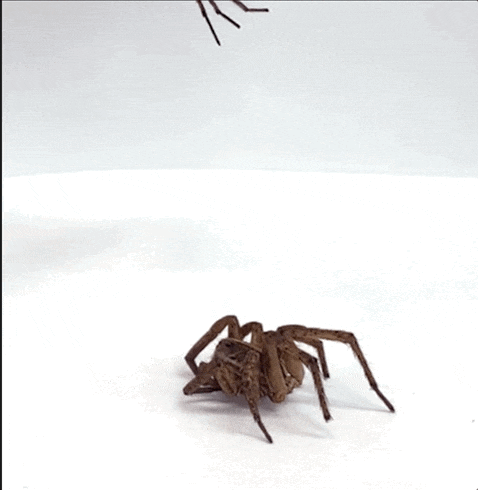Mechanical Engineering Prize
Citation: "Te Faye Yap, Zhen Liu, Anoop Rajappan, Trevor Shimokusu, and Daniel Preston, for re-animating dead spiders to use as mechanical gripping tools."

Rice University graduate student Faye Yap noticed a dead curled-up spider in the lab hallway one day and learned that spiders curl up when they die because of internal hydraulics. She thought it might be cool to use the bodies of dead spiders as tiny air-powered grippers for picking up and maneuvering tiny electronic parts. So Yap and her colleagues—including adviser Daniel Preston—did just that. They transformed a dead wolf spider into a gripping tool with just a single assembly step, essentially launching a novel research area they have cheekily dubbed "necrobotics."
As we reported last year, a spider's prosoma, or hydraulic chamber, contains internal valves that enable the creature to control each leg individually. Once the spider dies, that control is gone, and the legs work in unison. All they needed to do was insert a needle into the prosoma of a dead spider and affix it to the spider's body with superglue to form a hermetic seal. The whole process took 10 minutes. The other end of the needle is attached to either one of the lab's test rigs or a handheld syringe. Administering tiny puffs of air pressurizes the chamber and activates the legs instantaneously, causing them to open. Depressurizing the chamber causes the legs to close up again.
The team tested their spider-gripper on a variety of objects. For example, they used it to remove a jumper wire on an electric breadboard to disconnect the LED, to pick up a block of red-dyed polyurethane foam, and even to pick up another dead spider. The spider-gripper could reliably lift objects that were more than 1.3 times the spider's body weight, exerting a peak gripping force of 0.35 millinewton. The spider-gripper also proved to be surprisingly robust, completing 1,000 open/close cycles before the wear and tear on the joints caused the body to break down after a couple of days. As a bonus, the spider bodies are fully biodegradable.
Medicine Prize
Citation: "Christine Pham, Bobak Hedayati, Kiana Hashemi, Ella Csuka, Tiana Mamaghani, Margit Juhasz, Jamie Wikenheiser, and Natasha Mesinkovska, for using cadavers to explore whether there is an equal number of hairs in each of a person's two nostrils."
This study was triggered by an interest in alopecia areata, a condition marked by hair loss on one's scalp, eyelashes, eyebrows, and nostrils. Pham et al. noted that many people who suffer from this condition are more prone to upper respiratory infections, allergies, and dryness because the condition also depletes the nose hair lining each nostril. And they realized that nobody had actually gotten around to counting the average number of nose hairs in humans, a first step in assessing what effects the lack thereof could have on patients' quality of life.
So that's what they did, using 20 cadavers (10 male and 10 female) from the medical school at the University of California, Irvine. Not only were the hairs counted in each nostril, but they used a measuring tape to determine the distance of hair growth at the upper, lateral, and lower nostril. The results: The average nose hair count per nostril is between 120 and 122 hairs, and nose hairs typically grow over a range of 0.81 to 1.035 centimeters. Trot out those statistics next time you're desperate to make small talk at a cocktail party.
reader comments
113